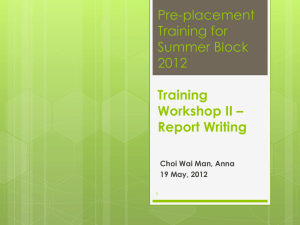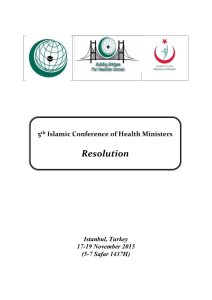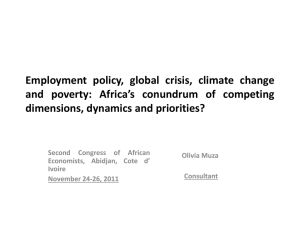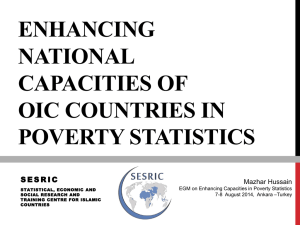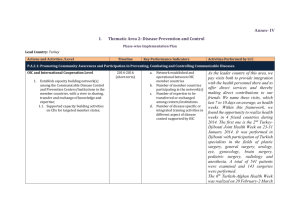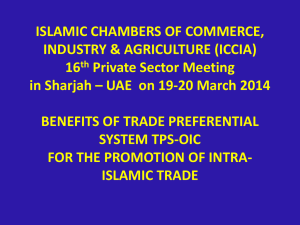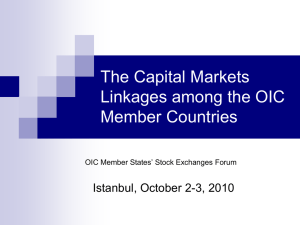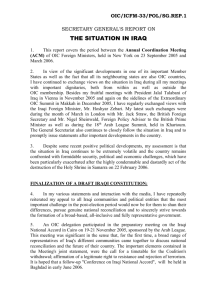Youth and Development in the IDB Member Countries
advertisement
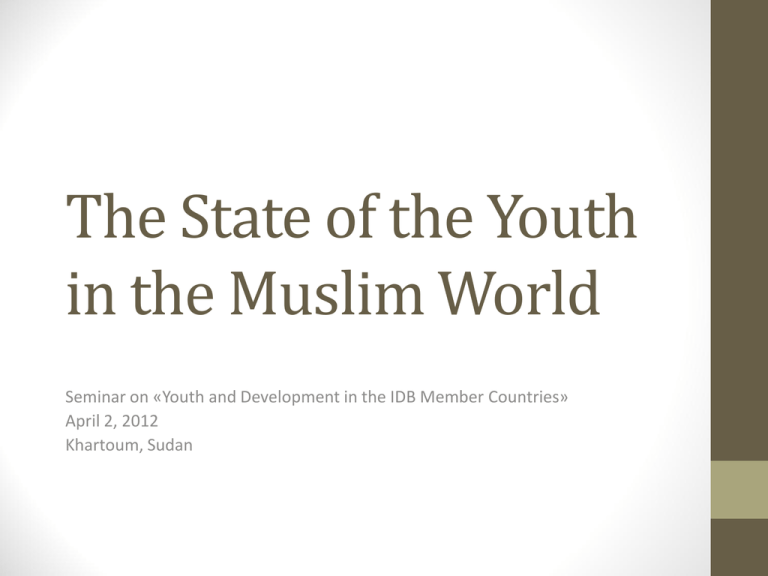
The State of the Youth in the Muslim World Seminar on «Youth and Development in the IDB Member Countries» April 2, 2012 Khartoum, Sudan Outline • Youth in the Member Countries • Challenges: Education and Employment • Consequences: Social unrest, poverty, conflict • Responses: Vocational Education and Training • SESRIC Responses: OIC-VET, SDYE, OIC-ISIP, IMTP, OIC-PAP • Final Remarks 2 Youth as a Strength The share of young population accounted for 53.5 PER CENT of the OIC total population in 2009 With 1.57 billion people in 2010, the OIC countries accounted for almost 23 per cent of the world total population. The share of the young population (age group 0-24) in the total population of the OIC countries reached 53.5 per cent in 2010; the highest share compared to all other groups of countries in the world. 1.57 BILLION PEOPLE Population of the OIC Countries in 2010 3 Higher percentage of young population will be the key driver of economic development Youth as a Challenge Poor quality education High youth unemployment with poverty and inequality Mismatch between composition of skills and the needs of the labour market 4 Youth as a Challenge High unemployment Poverty Inequality Social unrest 5 State of the Muslim Youth EDUCATION 6 Education – Average Schooling Year 1960 1970 1980 1990 2000 2010 2020 2030 2040 2050 Figure 7: Average Years of Schooling over a Century 0 2 4 6 8 Average Years of Schooling 10 12 Source: UN Data In OIC member countries, average years of schooling have substantially increased over the last 40 years. The number of countries with schooling more than 6 years was only 4 in 1970. This number increased to 26 in 2010. In 2030 the minimum years of schooling will be 4 years and in 2050 it will be 6 years. 7 Education – Average Spending The government expenditures on education per pupil as percentage of GDP per capita 25 23.5 20 20.5 21.2 1999 21.8 Percent 18.1 2008 18.2 16.5 16.3 15 10 5 0 World Developed Developing OIC Source: SESRIC (2010) World average government expenditures on education per pupil as percentage GDP per capita increased from 20.5% in 1999 to 21.2% in 2008. The increase in this ratio in developing countries as well as OIC countries was quite limited as compared to developed countries. 8 Education – Quality The mean performance of students on mathematics, reading and science for all 10 OIC countries taking part in the PISA study of OECD (2009) Among the 65 countries or economies surveyed in the study, 7 of the 10 worst performers on the overall reading scale are the OIC member countries. Turkey as the best performing OIC member country occupies only 41st position. Kyrgyzstan Azerbaijan Qatar Albania Kazakhstan Indonesia Tunisia Jordan Dubai (UAE) Turkey OECD Average 0 100 Science 200 300 Mathematics 400 Reading 500 600 Several studies illustrate the seriousness of the learning challenge. - More than 30 per cent of Malian youths aged 15–19 years who completed six years of schooling could not read a simple sentence. - In Pakistan, tests of grade 3 children found that only half could answer very basic multiplication questions (World Bank, 2011). 9 12 16 Figure 18: Schooling and Productivity Growth 8 TKM 4 NER MLI UGA SDN MOZ SLE GMB BFA BGDIDN NGA EGY LBY TUN IRN PAK IRQ KWT TUR SYRCOM MDV CMR DZA SAU GAB TGO MAR MRT BEN YEM SEN GIN TCD CIV 0 y = 0.112x + 2.5697 R-sqr = 0.023 UZB JOR TJK KAZ ALB ARE KGZ MYS BHR GUY BRN -4 Productivity Growth Education – Quality and Productivity 0 3 6 Average Years of Schooling 9 12 Source: SESRIC staff estimation and World Bank One year increase in average schooling is associated with 0.1% increase in productivity (GDP per worker) and this is a relatively poor improvement. 10 State of the Muslim Youth EMPLOYMENT 11 Skill Mismatch Skill Mismatch • An adequate basic education may not be enough to find work because they do not provide the skills needed by employers. • Despite persistent joblessness among young people, employers usually complain that they can’t find enough workers with the skills they need to grow their businesses. Broadening learning opportunities for the young, especially by improving quality • Better learning outcomes take more than investment in school buildings and classrooms, trained teachers and professors, and textbooks. • Special programs should be developed to teach young people to make good decisions when investing in their human capital, by giving them information, resources, and second-chance opportunities. 12 Youth Unemployment – OIC Countries Poor quality education High unemployment rates Skill mismatch 46.9 Unemployment, youth total (% of total labor force ages 15-24) 50.0 45.0 7.7 6.7 5.4 3.8 5.0 1.6 10.0 5.2 14.8 14.6 12.1 11.3 10.9 15.0 9.3 30.7 28.3 27.2 27.0 24.8 24.3 24.0 22.2 22.2 22.1 21.9 21.5 19.2 20.0 14.5 25.0 18.4 30.0 23.0 35.0 28.2 40.0 0.0 13 Youth Unemployment – Global and Regional In the Middle East and North Africa regions, youth are around four times as likely as adults to be unemployed, with youth unemployment rates well in excess of 25 per cent in both regions (ILO, Global Employment Trends 2012). The increase in social unrest in many countries and regions around the world is of little surprise. 14 Unemployment - Consequences Major impacts on economic growth due to the loss or degradation of human capital Wasted productive capacities Social injustice and inequality Other socioeconomic impacts: Increasing brain drain Youth Unemployment Lower lifetime earnings and poverty Lower life expectancy and even higher rates of suicide Higher crime rates and conflicts 15 Poverty: A Challenge for Social Equality Inadequate Education Unemployment Poverty According to the latest available estimates of World Bank, 351 million people (27% of OIC total population) were living below the income poverty threshold of 1.25$ a day whereas 640 million people (49% of OIC total population) were living below the poverty threshold of 2$ a day. Source: World Bank http://iresearch.worldbank.org/PovcalNet/index.htm?1 16 Poverty: A Challenge for Social Equality Poverty Headcount Ratio : % of population living in households with consumption or income per person below the poverty line. The default poverty line is $38.00 per month (Source: World Bank, 2012. http://iresearch.worldbank.org/PovcalNet/index.htm?1) 17 Poverty: A Challenge for Social Equality Although GDP per capita of OIC Member Countries was increasing for the last decade, the number of people living less than 1.25$ a day have not decreased, this fact points out unequal distribution of income in Member Countries. Source: World Bank, 2012. http://iresearch.worldbank.org/PovcalNet/index.htm?1 18 Poverty: A Challenge for Social Equality Unequal Redistribution of Wealth Income Share Held by Lowest and Highest 10% 0 Afghanistan Kazakhstan Tajikistan Iraq Mali Pakistan Egypt Sudan Bangladesh Togo Azerbaijan Kyrgyz Republic Palestine Indonesia Niger Jordan Albania Turkey Iran Senegal Guinea Cameroon Yemen Mauritania Cote d'Ivoire Burkina Faso Tunisia Gabon Morocco Malaysia Qatar Uganda Mozambique Nigeria 4.1 4.0 3.5 3.8 3.5 4.4 4.0 2.7 4.0 3.3 3.4 2.8 3.2 3.7 3.6 3.4 3.5 2.1 2.6 2.5 2.7 2.9 2.9 2.4 2.2 2.9 2.4 2.6 2.7 1.8 1.3 2.4 1.9 1.8 23.2 23.8 24.3 25.2 25.8 26.1 26.6 26.7 27.0 27.1 27.4 27.8 28.2 28.5 28.5 28.7 29.0 29.4 29.6 30.1 30.3 30.4 30.8 31.6 31.8 32.2 32.5 33.0 33.2 34.7 35.9 36.1 36.7 38.2 Income share held by lowest 10% Income share held by highest 10% OIC averages of income share held by highest 10% is approximately 29.7% and income share held by lowest 10% is 2.9%; implies that the top 10% of population take benefit of 30 percentage of GDP but the remaining 90% of population just gain 70 percentages of GDP. Despite the increase of GDP per capita of OIC Member Countries for the last decade, any improvement in unequal income distribution is observed. 19 Top 10 Internet Sites & Social Networking Top 5 Users in the World FACEBOOK Malaysia (5) Argentina (4) Egypt (3) Turkey (2) Indonesia (1) Google (1) Facebook (2) YouTube (3) Yahoo (4) Baidu (5) Wikipedia (6) Windows Live (7) Blogspot (8) QQ (9) Twitter (10) Increasing number of young people are participating in public debate, making use of high-tech communication tools and social networking sites such as Facebook and Twitter . Studies show that social media carried a cascade of messages about freedom and democracy, equality across North Africa and the Middle East and played a critical role in shaping opinions and influencing change, in the Arap Spring. 20 State of the Muslim Youth THREATS 21 Threats • A rising youth share of the population signals increases in the productive capacity of an economy on a per capita basis in the years to come. • It also poses a risk of social and political instability in economies that fail to generate sufficient jobs. Social unrests due to high unemployment rates • Millions of young people were chanting “dignity” and “social justice” in the MENA region, underlining deep-seated feelings of exclusion and inequality of opportunities. • Those who are unemployed and unmarried have relatively little to lose and relatively more to gain from change. New social media facilitate communication and organizing. • Demanding democracy, human rights, and better governance, young Arabs were also striving to realize their economic aspirations in a region rich in human and physical capital. • While there has been economic growth for a number of years in MENA countries, this has not led to an adequate number of good jobs and has succeeded, at best, in generating low-quality, informal jobs. 22 Informal Employment Informality as «lack of social security coverage» • A typical MENA country produces one-third of its GDP and employs 67 percent of its labor force informally. • Over two-thirds of workers may not have access to health insurance and/or are not contributing to a pension that provides income security after retirement. Source: World Bank, MENA Knowledge and Learning, Dec. 2011 The Schneider Index estimates the share of production not declared to tax and regulatory authorities 23 Social Exclusion Knowledge Gap of Muslim Youth • Muslim youth fail to have a thirst for knowledge • Lack of self-confidence Alienation of Muslim youth • Bridges between generations are being impaired and youth are becoming alienated from Muslim community. • Rising identity problem Idleness • Intellectual deficiency, emotional instability and reckless actions 24 RESPONSE: Good quality education, better employment prospects, preserving the moral values and sense of belonging Indonesia vs. Nigeria Indonesia • In 1980, Nigeria’s GDP per capita was slightly higher than that of Indonesia, but today it is only half that. • Indonesia used much of its oil revenue to educate its youth. • It successfully absorbed its young people into productive employment and elevated their standard of living. Nigeria • There are currently 32 million Nigerians ages 15 to 24, and more than double that number under the age of 15. • Investments in their skills and health, and in the physical capital, infrastructure, and institutions that will make them productive, will help determine Nigeria’s development success. • Failure to satisfy the desire of youth for productive engagement could further undermine political legitimacy, promote frustration and conflict, and deter investment. Source: IMF, Finance & Development March 2012 25 State of the Muslim Youth RESPONSES 26 Responses to the Challenge Enhancing Employability • Active Labour Market Policies and Vocational Education and Training Programmes Labour Market Challenges in the OIC Member Countries A significant portion of the jobs available are either low-quality informal jobs or formal jobs in the public sector Weak linkages between education institutions, enterprises and employment offices Concerns & Challenges Lack and low quality of vocational education and training trap the poor workers in low-skilled, low-productive and low-wage jobs Mismatch between composition of skills and capabilities and the needs of the labour market Difficulties for workers to move between jobs prevent them finding jobs suitable to their skills 27 SESRIC Responses to the Challenge Skill Development for Youth Employment PublicPrivate Partnership Skill Development for Youth Employment Matching Skills and Jobs On-the-jobtraining The initiative of the IDB and the World Bank (IFC): Education for Employment (e4e) With the aim of • Bridging the gap between existing education and employment • Narrowing the skills gap among young people in the Arab world 28 Skill Development for Youth Employment The study visit included 8 selected OIC Member Countries, namely Cameroon, Egypt, Indonesia, Kyrgyzstan, Morocco, Palestine, Senegal, and Tunisia. 29 11-13 January 2012, ANKARA / TURKEY Study Visit on Skill Development for Youth Employment OIC International Student Internship Programme (OIC-ISIP) A special programme developed under the OIC-VET Programme and operated under the International Business Forum (IBF) hosted by Independent Industrialists and Businessmen's Association (MÜSİAD). It basically aims at increasing knowledge and skills of university students about to enter into the labour market. 6 OCTOBER 2010, ISTANBUL / TURKEY Certificate Ceremony of OIC-ISIP Pilot Application of Summer 2010 10 students from 7 Member Countries, namely Afghanistan, Yemen, Albania, Senegal, Indonesia, Guinea, and Uzbekistan 30 ISMEK Master Trainer Programme 24-28 OCTOBER 2011, ISTANBUL / TURKEY Certificate Ceremony of the Master Trainers from Republic of Azerbaijan İSMEK Master Trainer Programme (IMTP) is a joint programme between Statistical Economic and Social Research and Training Centre for Islamic Countries (SESRIC) and the Centre for Art and Vocational Training Courses of Istanbul Metropolitan Municipality (İSMEK), initiated at beginning of 2011 and aims to provide training courses to master trainers in various vocational education institutions which targets to reduce youth unemployment rate in OIC Member Countries. 31 Poverty Alleviation Programme (OIC-PAP) SESRIC has established OIC Poverty Alleviation Programme (OIC-PAP) to have more active and vital role in coordination of all possible future events, trainings, capacity building programmes, research and other activities in the field of poverty alleviation. 32 Poverty Alleviation Programme (OIC-PAP) 33 Final Remarks • Youth as a strength • High share of young population • Youth as a challenge • Qualitative improvements in education is needed in addition to quantitative improvements • Provision of right skills to the young • Youth as a threat • Social unrests due to high unemployment rates • Responses to the challenges • International responses through ALMPs • SESRIC responses: OIC-VET, SDYE, OIC-ISIP,IMTP, OIC-PAP 34 State of the Muslim Youth DISCUSSIONS 35
